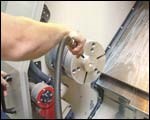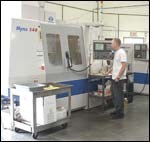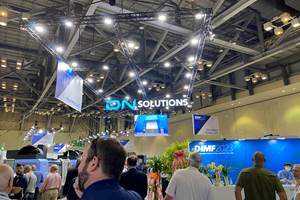An Analytical Approach To The Outsourcing Decision
The decision to manufacture in-house or send work overseas should not be based solely on labor cost. After an honest evaluation of its machining processes, this OEM found it was more profitable to bring work back in-house.
Probably every OEM in the United States has contemplated sending some or all of its manufacturing work overseas. The inexpensive labor base that some offshore manufacturers can currently tap is the enticing lure to outsource. If the sole target is to reduce manufacturing costs, then sending work outside the country may be a viable option.
However, there can be damaging consequences for companies that focus too intently on the cost of labor. When outsourcing work, manufacturers run the risk of losing proprietary information, receiving parts that don’t meet quality requirements and waiting for delayed shipments. These and other related issues are causing some companies to look for ways to retain and/or bring manufacturing work back in-house. In addition, those that take a close look at their manufacturing processes might identify production bottlenecks that, if opened, could bring component costs down to a level that is competitive with offshore manufacturers.
So what is an effective means of evaluating one’s process and making such a comparison? The methodologies likely vary from company to company. Innovative Turbo Systems (ITS), a manufacturer of turbocharger systems for the automotive aftermarket, is in the early stages of creating its own manufacturing self-evaluation procedure. ITS is a good example of a company with the discipline to thoroughly assess its own manufacturing capabilities—while identifying potential improvement areas—in order to make a sound business decision whether or not to outsource. These efforts have already resulted in a number of key components being brought back in-house, while competitors continue to rely on offshore vendors.
Time Studies
A tour of the ITS facility in Simi Valley, California, and a chat with Robert McKeirnan, the company’s new COO and vice president of engineering, revealed the struggles ITS faces in a highly competitive market. Mr. McKeirnan, who prior to joining ITS spent 11 years working for another turbine company, came to ITS with three goals in mind: 1) reduce manufacturing costs; 2) improve product quality; and 3) expand the product line. As he explains, the biggest challenge ITS faces is competing with turbocharger companies that primarily import components from the Pacific Rim area, where labor costs are low. “We’ve determined that the best way for ITS to compete with those companies is to develop new turbine technologies and product designs. After that, the key is to keep that intellectual property within the company. The best way to secure proprietary information is to bring all manufacturing work in-house.” When Mr. McKeirnan was brought on board in early 2005, the company machined 50 percent of its major turbo components. The goal is to increase that to figure to 100 percent.
ITS currently has two CNC machine tools from Daewoo (West Caldwell, New Jersey)—a Mynx 540 VMC and a Puma 230 lathe. It also has honing, fabricating and welding equipment to produce and assemble its turbocharger, tubing and intercooler components. Mr. McKeirnan’s first step in the journey to bring work in-house was to evaluate the current product line and manufacturing techniques. For the latter, he initiated time studies that break down total component cost in terms of individual process costs. These time studies are an ongoing means of continuously identifying the prime cost reduction targets for each component.
When evaluating a component in such a way, a number of manufacturing issues are considered. Operator cost is averaged across the entire project. This takes into account time required for setups, programming, loading new tools and fixtures, qualification, and also machining cycle time (when the operator might just be standing around waiting for operation to conclude). Mr. McKeirnan similarly looks at the cost of the electricity to run a machine, the amount of floorspace a machine requires, and material and initial machine costs. Using a basic spreadsheet, each of these costs is broken out in terms of percentage of total part manufacturing cost (see table on the following page).
A good example of a part that underwent this manufacturing examination is an aluminum seal plate that the company had been outsourcing because it was deemed too costly to produce in-house. When the seal plate was originally manufactured in-house, its total cost was comprised of:
- 57 percent—machine and operator costs
- 40 percent—material cost
- 3 percent—setup costs
Because machine and operator costs were found to be the largest portion of the part’s total cost, this became the company’s sole target for improvement. ITS identified a number of ways to reduce the setup time, in addition to making changes to the part program to reduce cycle times. The result was a new in-house manufacturing method using its existing CNC machines that cost 31 percent less than outsourcing (meaning part manufacturing could be brought back in-house).
However, the fact that the seal plate was now able to be produced in-house for less than the cost of outsourcing doesn’t mean that this was the end of the cost reduction efforts for that part. Mr. McKeirnan performed a second evaluation to determine the next target for cost reductions. For the seal plate, the new manufacturing cost percentages were determined to be:
- 65 percent—material cost
- 31 percent—machine and operator costs
- 4 percent—setup cost
The material cost now represented nearly two-thirds of the total part cost, and that became the new focus for cost reduction. It may be that the part could be created as an investment casting, rather than machined from billet material. This might be less costly than billet stock, but it could also reduce the amount of machining required by starting with a more net-shaped part. Alternately, a different, more affordable material that provides the characteristics required for the application could be used.
This process of identifying the prime manufacturing cost contributor and determining ways to improve upon that aspect of production continues. “Eventually, we will reach a stagnation point where no additional cost savings is realistically obtainable for that part,” Mr. McKeirnan explains.
Much of the work that ITS has been able to bring back in-house has been the result of improving the processes using existing machines. For example, the company has recently hired a new machine operator and programmer who has developed more efficient programs that have reduced the cycle times for some components. He has also found fixturing and workholding alternatives that have eliminated work-in-process (WIP). One such solution was to create softjaws to allow Op. 10 and Op. 20 routines in the same chuck for a cup-shaped component. For the first operation, the operator loads round billet into the chuck to machine the cup’s outer diameter to size. After that operation, the operator flips the workpiece so that a counterbore in the jaws can grip the OD for machining the internal cup profile. The part is then delivered to the VMC, which drills various holes.
New Equipment Matrix
Mr. McKeirnan recognizes that with only two CNC machine tools, additional equipment will be necessary at some point to pull more work in-house. The results found in the time studies are valuable in determining the features and capabilities a new machine tool should possess. In considering another type of machine tool, another spreadsheet decision matrix will be created. This will include a variety of process items that are also applied weight factors depending on their gaged importance. The results of the time studies feed into the type of features that new equipment should possess in order to:
- Decrease existing machine tool cycle times
- Increase the number of manufacturing operations per setup
- Decrease machine programming difficulty
- Decrease machine setup difficulty
Other machine features that are examined include service intervals, floorspace requirements, power consumption and initial machine cost. Of the machines evaluated so far, a lathe with live tooling seems to be a good fit for the types of parts used in a turbocharger. Another important consideration is that the machine would be able to perform turning and milling in one setup.
Just A Start
Mr. McKeirnan admits that the company has a long way to go. For example, consumables such as cutting tools and coolant currently aren’t considered in the time study evaluations. Finding ways to reduce setup times is a constant battle. The same can be said for eliminating WIP. The company may add assembly stations at each machine so that after a quick check with a go/no-go gage, an operator can assemble components while the machine is cutting other parts. Currently, assembly is done in a separate area of the facility. Job balancing is another target to facilitate assembly and reduce WIP. The seal plate is an example. While it takes 1 minute 40 seconds to machine two of these components in the VMC, it takes 3 minutes to complete the lathe work on a single part.
The time studies have also proven to Mr. McKeirnan how important it is to keep up with manufacturing technologies, such as new machine designs, CAD/CAM programming capabilities and workpiece fixturing, in order to keep the company and its employees moving in the profitable direction.
Related Content
DN Solutions Responds to Labor Shortages, Reshoring, the Automotive Industry and More
At its first in-person DIMF since 2019, DN Solutions showcased a range of new technologies, from automation to machine tools to software. President WJ Kim explains how these products are responses to changes within the company and the manufacturing industry as a whole.
Read MoreAll-Around Mill Improves Productivity and Cost for Valve Job
Adopting a mill with a double-negative rake and pockets compatible with multiple insert geometries enabled Progressive Metal Service to increase feed and lower scrap rates for a valve.
Read MoreIMTS Takeaways From the Modern Machine Shop Editorial Team
The first in-person IMTS in four years left the MMS editorial staff with a lot to digest. Here are a few of our takeaways from the show floor.
Read MoreFinally, A Comprehensive Software Solution Designed for Small Job Shops
Zel X from Siemens is an integrated software application that consolidates collaboration, design, manufacturing, and operations into a comprehensive, easy-to-use solution. From RFQ to delivery, it’s a more efficient way to handle quotes, manage jobs, make parts, and collaborate with teams of all sizes.
Read MoreRead Next
Obscure CNC Features That Can Help (or Hurt) You
You cannot begin to take advantage of an available feature if you do not know it exists. Conversely, you will not know how to avoid CNC features that may be detrimental to your process.
Read MoreThe Cut Scene: The Finer Details of Large-Format Machining
Small details and features can have an outsized impact on large parts, such as Barbco’s collapsible utility drill head.
Read More3 Mistakes That Cause CNC Programs to Fail
Despite enhancements to manufacturing technology, there are still issues today that can cause programs to fail. These failures can cause lost time, scrapped parts, damaged machines and even injured operators.
Read More
.jpg;width=70;height=70;mode=crop)











.png;maxWidth=300;quality=90)




















